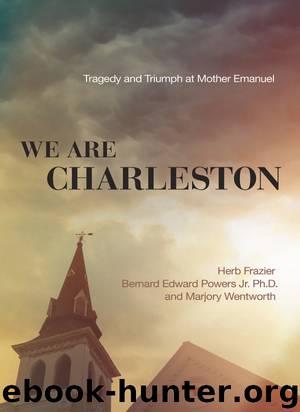We Are Charleston by Herb Frazier & Dr. Bernard Edward Powers Jr. & Marjory Wentworth

Author:Herb Frazier & Dr. Bernard Edward Powers Jr. & Marjory Wentworth
Language: eng
Format: epub
Publisher: Thomas Nelson
Published: 2016-04-30T16:00:00+00:00
TEN
CIVIL RIGHTS
Charleston’s white community had no intentions of discussing racial inequities even a century after Abraham Lincoln’s Emancipation Proclamation ended slavery in the old Confederacy. In early 1963, Charleston had settled into a comfortable social rhythm of racially divided schools, and lunch counters and retail jobs on King Street reserved just for whites, along with other bedrock Jim Crow restrictions. But this status quo was increasingly frustrating for Charleston’s black population. In the spring of that year, the civil rights movement’s “children’s hour” in Birmingham, Alabama, gave nonviolent protesters there the upper hand against the police force.1 A transfixed nation watched televised images of police dogs attacking children and high-pressure water hoses knocking them down. The NAACP in South Carolina used a similar strategy of engaging children on the front line for social justice.
An elaborate organization was designed in Charleston to stage meetings, prayer marches, restaurant and lunch counter sit-ins, theater stand-ins, parades, and picketing; this plan was backed by nearly twenty churches, a steering committee, and a woman’s group of thirty-four people, all directed by James G. Blake, the NAACP’s national youth chairman. Emanuel was selected as one of the sites for rallies, and B. J. Glover was assigned to recruit high-profile speakers for events.2 Glover and Blake, a student at Morehouse College in Atlanta, Georgia, the alma mater of Martin Luther King Jr., may have both asked King to speak at Emanuel and lead a march down King Street.
Before the Charleston movement’s launch on June 7, 1963, at Calvary Baptist Church, black South Carolinians had already secured federal court victories before District Court judge J. Waties Waring of Charleston, who was hailed by some as “the Moses for black people.”3 The corps of black lawyers who would take civil rights cases to state and federal courts in the 1960s resulted from a Waring decision. World War II veteran John H. Wrighten of Edisto Island near Charleston, a member of Mother Emanuel, was denied admission to the University of South Carolina Law School in Columbia in 1946, and his five attorneys, one of whom was NAACP lawyer Thurgood Marshall, filed a lawsuit in federal court.4 The following year Waring ruled that Wrighten was entitled to the same opportunity and facilities available to whites who pursued legal training in South Carolina. Waring gave South Carolina three choices: (1) admit Wrighten to USC; (2) establish a law school at the Colored Normal, Industrial, Agricultural and Mechanical College of South Carolina in Orangeburg, South Carolina; or (3) close the USC law school.
South Carolina chose to open a law school at the Orangeburg campus. By the 1960s, Wrighten’s lawsuit had produced a windfall for black activists. The law school not only trained Wrighten, who is considered the “granddaddy” of black lawyers in the state, but it also produced others who became the friendly faces in state and federal courts to argue civil rights cases. Among them were Emanuel member and South Carolina Circuit Court judge Daniel E. Martin Sr.; South Carolina Supreme Court chief justice Ernest A.
Download
This site does not store any files on its server. We only index and link to content provided by other sites. Please contact the content providers to delete copyright contents if any and email us, we'll remove relevant links or contents immediately.
Joan of Arc by Mary Gordon(4017)
Victory over the Darkness by Neil T. Anderson(2819)
The Gnostic Gospels by Pagels Elaine(2472)
Devil, The by Almond Philip C(2283)
The Nativity by Geza Vermes(2181)
The Psychedelic Gospels: The Secret History of Hallucinogens in Christianity by Jerry B. Brown(2122)
Going Clear: Scientology, Hollywood, and the Prison of Belief by Lawrence Wright(1940)
Going Clear by Lawrence Wright(1926)
A TIME TO KEEP SILENCE by Patrick Leigh Fermor(1864)
Barking to the Choir by Gregory Boyle(1786)
Old Testament History by John H. Sailhamer(1769)
Augustine: Conversions to Confessions by Robin Lane Fox(1737)
A History of the Franks by Gregory of Tours(1687)
A Prophet with Honor by William C. Martin(1685)
The Bible Doesn't Say That by Dr. Joel M. Hoffman(1652)
The Knights Templar by Sean Martin(1630)
by Christianity & Islam(1596)
The Source by James A. Michener(1540)
The Amish by Steven M. Nolt(1533)
